首都医科大学生理学2019年考博真题考博试卷
医学博士生考试真题
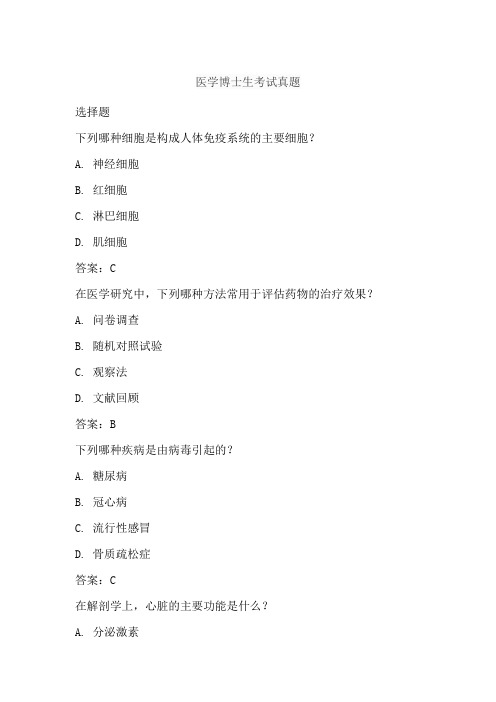
医学博士生考试真题选择题下列哪种细胞是构成人体免疫系统的主要细胞?A. 神经细胞B. 红细胞C. 淋巴细胞D. 肌细胞答案:C在医学研究中,下列哪种方法常用于评估药物的治疗效果?A. 问卷调查B. 随机对照试验C. 观察法D. 文献回顾答案:B下列哪种疾病是由病毒引起的?A. 糖尿病B. 冠心病C. 流行性感冒D. 骨质疏松症答案:C在解剖学上,心脏的主要功能是什么?A. 分泌激素B. 储存血液C. 泵送血液D. 消化食物答案:C下列哪种激素由甲状腺分泌,对机体代谢和生长发育有重要作用?A. 胰岛素B. 生长激素C. 甲状腺素D. 肾上腺素答案:C名词解释肝肾综合征(HRS):又称功能性肾衰,以自发性少尿或无尿、氮质血症、稀释性低钠血症和低尿钠为特征,而肾脏无明显病理改变。
肠易激综合征(IBS):是一种腹痛或腹部不适伴排便习惯改变为特征的功能性肠病,经检查排除可引起这些症状的器质性疾病。
卓-艾综合征(胃泌素瘤):由胰腺非β细胞瘤分泌大量胃泌素所致,肿瘤一般很小(<1cm),生长缓慢,半数为恶性。
简答题自发性气胸的治疗原则:根据气胸类型、病因、发生频次、肺萎缩程度、病情状态及有无并发症等,酌情选择保守治疗或手术治疗。
一般首次发生的症状较轻的闭合性气胸,可先行保守治疗。
保守治疗无效或复发、引流后持续漏气、血气胸、长期气胸、张力性气胸引流失败者可考虑手术治疗。
支气管哮喘典型的临床表现:反复发作性伴有哮鸣音的呼气性呼吸困难。
症状可在数分钟内发生,并持续数小时至数天,可经平喘药物治疗后缓解或自行缓解。
夜间及凌晨发作和加重常是哮喘的特征之一。
肿瘤外科治疗的原则:无瘤原则:指在切除肿瘤时及整个手术过程中,防止肿瘤细胞的扩散和种植,这是肿瘤外科治疗的基本原则。
整块切除原则:强调在手术中应整块切除肿瘤及其周围正常组织,以防止肿瘤细胞的扩散。
根治性原则:在切除肿瘤时,应同时切除肿瘤周围可能受累的淋巴结和软组织,以达到根治的目的。
首都医科大学博士入学考试试题汇总
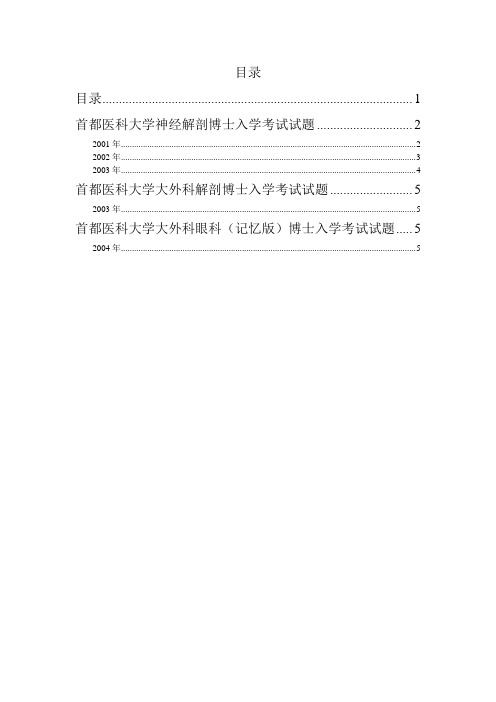
目录目录 (1)首都医科大学神经解剖博士入学考试试题 (2)2001年 (2)2002年 (3)2003年 (4)首都医科大学大外科解剖博士入学考试试题 (5)2003年 (5)首都医科大学大外科眼科(记忆版)博士入学考试试题 (5)2004年 (5)首都医科大学神经解剖博士入学考试试题2001年一、名词解释(1-7题,5×7=35;2-12题,3×5=15)1、边缘系统2、脊髓灰质板层3、后屈束4、内侧纵束1、攀缘纤维2、下橄榄核3、桥小脑三角4、 phrenic n.5、 celiac plexus10、obturator n.11、locus reculeus12、carvernous sinus二、问答题(10×5=50)1、纹状体① 位置及组成② 纤维联系③ 化学递质环路④ 动脉供应2、网状结构① 定义② 主要核团③ 机能组合3、神经支配① 肾上腺髓质② 斜方肌③ 二腹肌④ 蚓状肌4、解剖基础① 交叉性瘫痪② 屈曲反射③ 翼状肩④ 猿手5、“听新闻记纪录”的解剖学基础2002年简答:被盖中央束阴捕神经黑质蓝斑论述:1脑干的非脑神经节脑干的运动型交叉纤维Wallenberg的解剖基础2副交感神经系统的二级神经元交通支颌部区的立毛肌支配(不知道该题是否准确)3小脑皮质神经元环路海马结构的分层和分区脑室的边界和CSF的循环2003年名词解释1. 肋间壁神经2. 鼻睫神经3. Ⅶ颅神经4. great petrosol N5. confluence of sinuse6. central tegmentrol decussation简答1. 底丘脑的神经纤维联系2. 下肢非意识感觉到大脑的纤维联系3. 如何理解cerebelar glomorulus论述1. 边缘系统组成;PAPEZ环路;Hippocampal分层。
2. 白质通路和灰质通路;牵涉痛;Otic Ganglion。
2007首都医科大学考博生理题(暂缺答案)

2007首都医科大学考博生理题(暂缺答案)(总分:26.00,做题时间:180分钟)一、名词解释(总题数:20,分数:20.00)1.EPSP(分数:1.00)__________________________________________________________________________________________ 2.Decerebrate Rigidity(去大脑强直,大脑切除后僵硬,去大脑僵直)(分数:1.00)__________________________________________________________________________________________ 3.Ascending Reticular Activating System(上行网状激活系统)(分数:1.00)__________________________________________________________________________________________ 4.REM(分数:1.00)__________________________________________________________________________________________ 5.应激系统(分数:1.00)__________________________________________________________________________________________ 6.腱反射(分数:1.00)__________________________________________________________________________________________ 7.允许作用(分数:1.00)__________________________________________________________________________________________ 8.肺泡通气量(分数:1.00)__________________________________________________________________________________________ 9.波尔效应(分数:1.00)__________________________________________________________________________________________ 10.胃容受性舒张(分数:1.00)__________________________________________________________________________________________ 11.肠-胃反射(分数:1.00)__________________________________________________________________________________________ 12.渗透性利尿(分数:1.00)__________________________________________________________________________________________ 13.血浆清除率(分数:1.00)__________________________________________________________________________________________ 14.泊肃叶定律(分数:1.00)__________________________________________________________________________________________15.IP3受体(分数:1.00)__________________________________________________________________________________________ 16.局部反应(分数:1.00)__________________________________________________________________________________________ 17.递质的量子释放(分数:1.00)__________________________________________________________________________________________ 18.超射(分数:1.00)__________________________________________________________________________________________ 19.促红细胞生成素(分数:1.00)__________________________________________________________________________________________ 20.Rh血型(分数:1.00)__________________________________________________________________________________________ 二、简述(总题数:6,分数:6.00)21.简述皮肤痛、内脏痛、快痛、慢痛、牵涉痛?(分数:1.00)__________________________________________________________________________________________ 22.试述突触传递全过程?(分数:1.00)__________________________________________________________________________________________ 23.肾脏的血液循环有何特点及意义?(分数:1.00)__________________________________________________________________________________________ 24.简述基本电节律概念、产生机制、生理学意义?(分数:1.00)__________________________________________________________________________________________ 25.说明NO在调节血管张力方面的作用及机制?(分数:1.00)__________________________________________________________________________________________ 26.请结合心肌代谢和冠脉解剖特点,论述冠脉血流的影响因素及其血流量的调节?(分数:1.00)__________________________________________________________________________________________。
首医考博生理真题2006-2016年
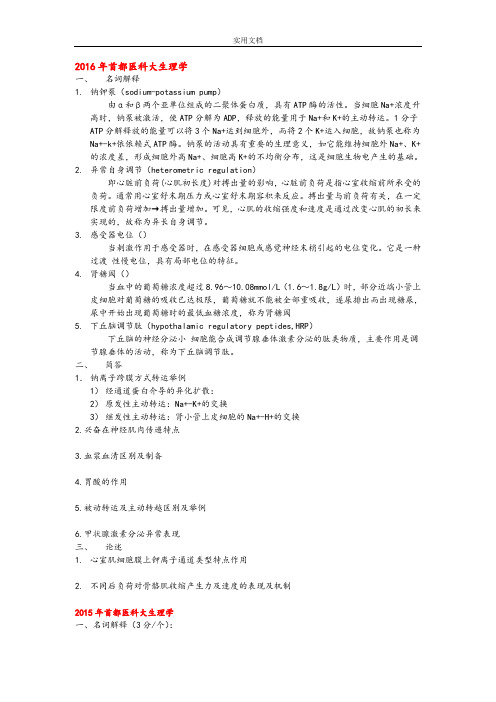
2016年首都医科大生理学一、名词解释1.钠钾泵(sodium-potassium pump)由α和β两个亚单位组成的二聚体蛋白质,具有ATP酶的活性。
当细胞Na+浓度升高时,钠泵被激活,使ATP分解为ADP,释放的能量用于Na+和K+的主动转运。
1分子ATP分解释放的能量可以将3个Na+运到细胞外,而将2个K+运入细胞,故钠泵也称为Na+-k+依依赖式ATP酶。
钠泵的活动具有重要的生理意义,如它能维持细胞外Na+、K+的浓度差,形成细胞外高Na+、细胞高K+的不均衡分布,这是细胞生物电产生的基础。
2.异常自身调节(heterometric regulation)即心脏前负荷(心肌初长度)对搏出量的影响,心脏前负荷是指心室收缩前所承受的负荷。
通常用心室舒末期压力或心室舒末期容积来反应。
搏出量与前负荷有关,在一定限度前负荷增加→搏出量增加。
可见,心肌的收缩强度和速度是通过改变心肌的初长来实现的,故称为异长自身调节。
3.感受器电位()当刺激作用于感受器时,在感受器细胞或感觉神经末梢引起的电位变化。
它是一种过渡性慢电位,具有局部电位的特征。
4.肾糖阈()当血中的葡萄糖浓度超过8.96~10.08mmol/L(1.6~1.8g/L)时,部分近端小管上皮细胞对葡萄糖的吸收已达极限,葡萄糖就不能被全部重吸收,遂尿排出而出现糖尿,尿中开始出现葡萄糖时的最低血糖浓度,称为肾糖阈5.下丘脑调节肽(hypothalamic regulatory peptides,HRP)下丘脑的神经分泌小细胞能合成调节腺垂体激素分泌的肽类物质,主要作用是调节腺垂体的活动,称为下丘脑调节肽。
二、简答1.钠离子跨膜方式转运举例1)经通道蛋白介导的异化扩散:2)原发性主动转运:Na+-K+的交换3)继发性主动转运:肾小管上皮细胞的Na+-H+的交换2.兴奋在神经肌肉传递特点3.血浆血清区别及制备4.胃酸的作用5.被动转运及主动转越区别及举例6.甲状腺激素分泌异常表现三、论述1.心室肌细胞膜上钾离子通道类型特点作用2.不同后负荷对骨骼肌收缩产生力及速度的表现及机制2015年首都医科大生理学一、名词解释(3分/个):1.肾小球滤过率2.牵反射3.继发性主动转运二、简答题七个(5分/个):1.载体易化扩散的特点2.血小板的生理功能3.影响心输出量的因素4.肺泡表面物质的作用5.影响肾小球滤过的因素6.非突触化学传递的特点三、论述题两个(15分/个)1.脑干网状系统对骨骼肌肌紧的调节作用、活动特点以及如何用实验证明;2.中等量失血,循环系统和泌尿系统有何变化?2014年首都医科大生理学一选择题:1.兴奋性周期变化顺序:2.骨骼肌兴奋收缩Ca来源:3.人安静时通气量/血流比值:4.参与尿液稀释浓缩的激素:5.使组织液生成减少的是:6.食物的氧热价:7.影响兴奋在心脏传导速度最重要因素:8.心脏的异长调节指:9.肺泡回缩是由于:10.快速叩击脚腱,刺激与肌肉相连的什么结构引起肌肉收缩:11.脊髓前角r运动神经元传出冲动增加,会导致:12.消化时胃肠运动属于:13.什么物质可以用于检测肾小球滤过速率:14.什么结构对肾小球滤过的通透性无关:15.骨骼肌放在高渗任氏液中,刺激后会发生现象:16.换气时氧的扩散系数与二氧化碳相比:17.盐酸抑制胃活动通过什么方式:18.心房容积在什么期最大:二、名词解释:1、等长收缩(isometric contraction)肌肉收缩时长度保持不变而只产生力增加称为等长收缩。
医学考博2019真题

Listening :无Vocabulary :Section A31. According to the Geneva ______no prisoners of war shall be subject to abuse.A. CustomsB. CongressesC. ConventionsD. Routines 32. Environmental officials insist that something be done to ______acid rain.A. curbB. sueC. detoxifyD. condemn33. It is impossible to say how it will take place, because it will happen______, and itwill not be a long process.A. spontaneouslyB. simultaneouslyC. principallyD. approximately34. Diabetes is one of the most______ and potentially dangerous disease in the world.A. crucialB. virulentC. colossalD. prevalent35. Rheumatologist advises that those with ongoing aches and pains first seek medicalhelp to ______the problem.A. affiliateB. alleviateC. aggravateD. accelerate36. How is it possible that such______ deception has come to take place right underour noses?A. obviousB. significantC. necessaryD. widespread37. Now a paper in Science argues that organic chemicals in the rock come mostly from______on earth rather than bacteria on Mars.A. configurationB. constitutionC. condemnationD. contamination38. Chronic high-dose intake of vitamin A has been shown to have ______effects onbones.A. adverseB. prevalentC. instantD. purposeful39. Generally, vaccine makers _____ the virus in fertilized chicken eggs in a processthat can take four to six months.A. penetrateB. designateC. generateD. exaggerate40. We are much quicker to respond, and we respond far too quickly by giving ______to our anger.A. ventB. impulseC. temperD. offenceSection B41. The patient's condition has worsened since last night.A. improvedB. returnedC. deterioratedD. changed42. Beijing Television-Station Transmitting Tower really looks magnificent at nightwhen it ’s lit up.A. decoratedB. illustratedC. illuminatedD. entertained43. Attempts to restrict parking in the city centre have further aggravated the problemof traffic congestion.A. amelioratedB. aggregatedC. deterioratedD. duplicated44. The applications of genetic engineering are abundant and choosing oneappropriate for this case can be rather difficult.A. sufficientB. plentifulC. adequateD. countable45. The defect occurs in the first eight weeks of pregnancy, though no one understandswhy.A. deficitB. deviationC. draw backD. discrepancy46. He has been on hormone alternate therapy for four years and looks fantastic.A. successorB. replacementC. surrogateD. choice47. It had over 2,000 apartment complexes, a great market, a large number ofindustrial workshops, an administrative center, a number of massive religious edifices,and a regular grid pattern of streets and buildings.A. ancientB. carefullyC. very largeD. carefully protected48. When patients spend extended periods in hospital, they tend to become overlydependent and lose interest in taking care of themselves.A. extremelyB. exclusivelyC. exactlyD. explicitly49. The anxious parent was vigilant over the injured child in spite of a full array ofemergency room of doctors and nurses.A. preoccupiedB. unwaryC. watchfulD. dozing50. The doctor vacillated so frequently on disease-preventiontechniques that hiscolleagues accused him of inconsistency.A. waveredB. instigatedC. experimentedD. reliedClozeWe spend a lot of time looking at the eyes of others for social 51 —it helpsus understand a person ’emotions, and make decisions about how to respond to them. We also know that adults avoid eye contact when anxious. But researchers have knownfar 52 about eye gazing patterns in children.According to new research by Kalina Michalska, assistant professor of psychologyat the University of California, Riverside, we now, know that anxious children tend toavoid making eye contact, and this has consequences for how they experience fear. The53 and less frequently they look at the eyes of others, the more likely they are to beafraid of them, even when there may be no reason to be. Her study, “Anxiety Sympand Children's Eye Gaze During Fear Leaming”w,as published in the journal TheJournal of Child Psychology and Psychiatry."Looking at someone ’s eyes helps us understand whether a person is feeling sad, angry, fearful, or surprised. As adults, we then make decisions about how to respondand what to do next. But, we know much less about eye patterns in children —so,understanding those patterns can help us learn more about the development of sociallearning, ”Michalska said.Michalska and the team of researchersshowed 82 children, 9 to 13 years old,images of two women ’s faces on a computer screen. The computer was equipped withan eye tracking device that allowed them to measure54 on the screen children werelooking, and for how long. The participants were originally shown each of the twowomen a total of four times. Next, one of the images was55 with a loud scream anda fearful expression, and the other one was not. At the end, children saw both facesagain without any sound or scream.The following three conclusions can be drawn from the study:1. All children spent more time looking at the eyes of a face that was paired withthe loud scream t han the face that was not paired with the scream, 56 they payattention to potential threats even in the absence of outward cues.2. Children who were more anxious avoided eye contact during all three phases of the experiment, for both kinds of faces. This had consequences for how afraid they wereof the faces.3. The more children avoided eye conta;cthe more afraid they were 57 the faces.The conclusions suggest that children spend more time looking at the eyes of aface when previously paired with something frightening suggesting they pay moreattention to potentially threatening information as a way to learn more about thesituation and plan what to do next.However, anxious children tend to avoid making eye contact, which leads togreater 58 experience. Even though avoiding eye contact may reduce anxiety59 , the study finds that — over time — children may be m i s s6i n0g_ o i m u p t ortantsocial information. This includes that a person may no longer be threatening or scary,and yet the child continues feeling fearful of that person.51. A. environment B. cues C. relations D. answers52. A. less B. more C. enough D. beyond53. A. longer B. more anxious C. shorter D. more54. A. where B. when C. how D. what55. A. followed B. recorded C. paired D. marked56. A. suggest B. suggesting C. suggests D. being suggested57. A. to B. of C.at D. about58. A. fear B. surprise C. sad D. angry59. A. in the long run B. for a long timeC. in the short timeD. in a long time60. A. with B. without C. of D. onReading ComprehensionPassage OneThe British psychoanalyst John Bowlby maintains that separation from the parentsduring the sensitive “attachment p”e riod from birth to three may scar a child ’s personality and predispose to emotional problems in later life.Some people have drawn the conclusion from Bowlby' s work that children shouldnot be subjected to day care before the age of three because of the parental separationit entails, and many people do believe this. It has been argued that an infant under threewho is cared for outside the home may suffer because of the separation from his parents. But there are also arguments against such a strong conclusion.But traditional societies are so different from modem societies that comparisonsbased on just one factor are hard to interpret. Firstly, anthropologists point out that theinsulated love affair between children and parents found in modem societies does notusually exist in traditional societies. For example, in some tribal societies, such as theNgoni, the father and mother of a child did not rear their infant alone —far from i Certainty, Bowlby ’s analysis raises the possibilities that early day care had delayedeffects. The possibility that such care might lead to, say, more mental illness or crime15 or 20 years later can only explored by the use of statistics. However, statisticalstudies of this kind have not yet been carried out, and even if they were, the resultswould certainly be complicated and controversial. Secondly, common sense tells us that day care would not be so widespread today if parents, care-takers found children hadproblems with it. Thirdly, in the last decade, t here have been a number of careful American studies of children in day care, and they have uniformly reported that care had a neutral or slightly positive effect on children ’s development.Whatever the long-term effects, parents sometimes find the immediate effectsdifficult to deal with. Children under three are likely to protest at leaving their parentsand show unhappiness. At the age of three or three and a half almost all children findthe transition to nursery eas,yand this is undoubtedly why more and more parents make use of child care at this time. The matter, then, is far from clear-cut, though experienceand available evidence indicate early care is reasonable for infants.61. According to the passage, the consequence of parental separation________.A. still needs more statistical studiesB. has been found negative is more seriousC. is obviousD. in modem times62. The author thinks that John Bowlby ’s concern___________.A. is relevant and justifiableB. is too strong to RelieveC. is utterly groundlessD. has something that deserve our attention63. What ’s the result of American studies of children in day care in the last decade?A. The children ’s unhappiness and protest was due to the day care the children received.B. The bad effects of parental separation were hard to deal with.C. The effect of day care was not necessarily negative on children ’s development.D. Early care was reasonable for babies since it ’p sracti c ed by so many peoplenowadays.64. According to the passage, which of the following is probably a reason forparents to send their children under three to day care?A. They don ’t know about day care ’s negative effect.B. They are too busy to care fortheir children.C. They want their children to be independent as early as possible.D. They want to facilitate their children to adapt to nursery at the age of about three.65. What ’s the author ’s attitude to people who have drawn the conclusion fromBowlby’s work that children should not be subjected to day care before the age ofthree?A. He supports most of their belief because Bowlby's proposition is well-grounded.B. He is sympathetic for them, for he thinks they have been misled by Bowlby.C. He doesn't totally agree with them, since the long-term effect of day care still needsfurther study.D. He doesn't quite understand them, as they are contradictory in themselves.Passage TwoBy the end of this century, the average world temperature is expected to increasebetween one and four degrees, with widespread effects on rainfall, sea levels and animalhabitats. But in the Arctic, where the effects of climate change are most intense, the risein temperature could be twice as much.Understanding how Arctic warming will affect the people, animals, plant andmarine life and economic activity in Canada’N sort h are important to the country's future, says Kent Moore, an atmospheric physicist at University of Toronto Mississaugawho is participating in a long-term, international study of the marine ecosystem alongthe Beaufort Sea, from Alaska to the Mackenzie delta.The study will add to our knowledge of everything from the extent of sea ice inthe region to how fish stocks will change to which areas could become targets for oiland gas exploration to the impact on the indigenous people who call this part of thecountry home.Moore, who has worked in the Arctic for more than 20 years, says his research hasalready found that thinning sea ice and changes in wind patterns are causing animportant change in the marine food chain: phytoplankton(淳游植物) is blooming two to three weeks earlier. Manyanimals time their annual migration to the Arctic forwhen food is plentiful, and have not adapted to the earlier bloom. " ' Animals' behaviorcan evolve over a long time, but these climate changes are happening in the space of adecade, r ather than hundreds of years, ”says Moore, " Animals can't change theirbehavior that quickly. ”A warmer Arctic is expected to have important effects on human activity in theregion, as the Northwest Passage becomes navigable during the summer, and resourceextraction becomes more feasible. Information gained from the study will helpgovernment, industry and communities make decisions about resource management,economic development and environmental protection.Moore says the study — which involves Canadian, American and Europeanresearchersand government agencies will also use a novel technology to gatheratmospheric data: remotely piloted drones. "The drones have the capability of a largeresearch aircraft,and they ’re easier to deploy, ” he says, showing the researchers to gather information on a more regular basis than they would be able to with pilotedaircraft.66. By the end of this century, according to the author, global warming will ______.A. start to bring about extreme weather events to humans and animalsB. increase the average world temperature by four degreesC. cause more damages to the whole world than expectedD. affect the Arctic more than any other parts of the earth67. To help understand the destructive mechanism of Arctic warming, as indicatedby the passage, the international study ______.A. is conducted with every single discipline of University of TorontoB. pioneers in pursuing the widespread effects of climate changeC. involves so many countries for different investigationsD. is intended to deal with various aspects in research68. When he ways, “Animals can ’t change their behavior that quickly, ”what doesMoore mean by that quickly?A. The migration of the animals to the Arctic.B. The widespread effects of global warming.C. The rate of the climate change in the Arctic.D. The phytoplankton within the marine ecosystem.69. According to the author, to carry out proper human activities in theArctic______.A. becomes more difficult than ever beforeB. is likely to build a novel economy in the regionC. will surely lower the average world temperatureD. needs the research-based supporting information70. With the drones deployed, as Moore predicts, the researchers will _______.A. involve more collaborating countries than they do nowB. get more data to be required for their researchC. use more novel technologies in researchD. conduct their research at a regular basisPassage ThreeHaving too much caffeine during pregnancy may impair baby ’s liver development and increase the risk of liver disease in adulthood, according to a study published in theJournal of Endocrinology. Pregnant rats given caffeine had offspring with lower birth weights, altered growth and stress hormonelevels and impaired liver development. Thestudy findings indicate that consumption of caffeine equivalent to 2-3 cups of coffee may alter stress and growth hormone levels in a manner that can impair growth and development, and increase the risk of liver disease in adulthood.Previous studies have indicated that prenatal caffeine intake of 300 mg/day ormore in women, which is approximately 2 to 3 cups coffee per day, can result in lower birth weights of their children. Animalstudies have further suggestedthat prenatalcaffeine consumption may have more detrimental long-term effects on liverdevelopment with an increased susceptibility to non-alcoholic fatty liver disease, adebilitating condition normally associated w ith obesity and diabetes. However, theunderlying link between prenatal caffeine exposure and impaired liver developmentremains poorly understood. A better understanding of how caffeine mediates theseeffects could help prevent these health issues in people in the future.In this study, Prof Hui Wang and colleagues at Wuhan University in China,investigated the effects of low (equivalent to 2-3 cups of coffee) and high dose(equivalent of 6-9 cups of coffee) caffeine, given to pregnant rats, on liver function andhormone levels of their offspring. Offspring exposed to prenatal caffeine had lower levels of the liver hormone, insulin likegrowth factor (IGF-1), and higher levels of thestress hormone, corticosteroid at birth. However, liver development after birth showed a compensatory 'catch up' phase, characterised by increased levels of IGF-1, which is important for growth.Dr. Yinxian Wen, study co-author, says, “Our results indicate that prenatal caffeine causes an excess of stress hormone activity in the mother, which inhibits IGF-1 activityfor liver development before birth. However, compensatory mechanisms do occur after birth to accelerate growth and restore normalliver function, as IGF-1 activity increasesand stress hormone signalling decreases. The increased risk of fatty liver disease causedby prenatal caffeine exposure is most likely a consequence of this enhanced,compensatory postnatal IGF-1 activity. ”These findings not only confirm that prenatal caffeine exposure leads to lowerbirth weight and impaired liver development before birth but also expand our currentunderstanding of the hormonal changes underlying these changes and suggest thepotential mechanism for increased risk of liver disease in the future. However, theseanimal findings need to be confirmed in humans.Dr. Wen comments, "Our work suggeststhat prenatal caffeine is not good for babies and although these findingsstill need to be confirmed in people, I wouldrecommend that women avoid caffeine during pregnancy."71. Which of the following is NOT the problem of baby rats of pregnant rats givencaffeine?A. Lower birth weight.B. Smaller stress.C. Liver development problem.D. Growth problem.72. If a pregnant woman takes 3 cups of coffee, what will probably happen?A. Her weight will get lower and lower.B. The weight of her baby will get lower and lower.C. She will suffer from non-alcoholic fatty liver disease in a long run.D. Her baby will be more vulnerable to obesity and diabetes because of liver problem.73. Which of following is not correct according to the passage?A. A better understanding of the relationship between caffeine and effects has beenachieved.B. 4-5 cups of coffee could be categorized as medium-dose intake.C. Liver development problem may be remedied after birth by increased growth factor.D. The study is mainly conducted on the rats instead of human.74. What is the relationship between stress hormone and liver development whentaking in prenatal caffeine?A. Lower stress hormone, lower birth weight before birth.B. Higher stress hormone, lower growth hormone before birth.C. Higher stress hormone, more accelerated growth of weight after birth.D. Lower stress hormone, less accelerated growth of liver after birth.75. What can be the best summary of the last paragraph?A. The research hasn ’t been done on humans so pregnant women can ignore the results.B. The compensatory mechanism for liver growth makes prenatal caffeine intake safe.C. Experts suggest pregnant women should still avoid caffeine.D. We have known enough about the hormone changes underlying the healthPassage FourThe bizarre antics of sleepwalkers have puzzled police, perplexed scientists, and fascinated writers for centuries. There is an endless supply of stories about sleepwalkers.Persons have been said to climb on steep roofs, solve mathematical problems, composemusic, walk through plate-glass windows, and commit murder in their sleepHow many of these stories have a basis in fact, and how many are pure fakery?No one knows, but if some of the most sensational stories should be taken with a barrelof salt, others are a matter of record.In Revere, Massachusetts, a hundred policemen combed a waterfrontneighborhood for a lost boy who left his home in his sleep and woke up five hours lateron a strange sofa in a strange living room, with no idea how he had got there.There is an early medical record of a somnambulist who wrote a novel in his sleep.And the great French writer V oltaire knew a sleepwalker who once got out of bed,dressed himself, made a polite bow, danced a minuet, and then undressed and went backto bed.At the University of Iowa, a student was reported to have the habit of getting upin the middle of the night and walking three-quarters of a mile to the Iowa River. He would take a swim and then go back tohis room to bed.The world's champion sleepwalker was supposed to have been an Indian, PanditRamrakha, who walked sixteen miles along a dangerous road without realizing that hehad left his bed. Second in line for the title is probably either a Vienna housewife or a British farmer. The woman did all her shopping on busy streets in her sleep. The farmer,in his sleep, visited a veterinarian miles away.The leading expert on sleep in America claims that he has never seen a sleepwalker.He is Dr. Nathaniel Kleitman, a physiologist at the University of Chicago. He is said toknow more about sleep than any other living man, and during the last thirty-five yearshad lost a lot of sleep watching people sleep. Says he, "Of course, I know that there are sleepwalkers becauseI have read about them in the newspapers. B ut none of mysleepers ever walked, and if I were to advertise for sleepwalkers for an experiment, Idoubt that I'd get many takers."Sleepwalking, nevertheless, is a scientific reality. Like hypnosis, it is one of thosedramatic, eerie, awe-inspiring phenomena that sometimes border on the fantastic. Itlends itself to controversy and misconceptions, what is certain about sleepwalking isthat it is a symptom of emotional disturbance, and that the only way to cure it is to remove the worries and anxieties that cause it. Doctors say that somnambulism is muchmore common than is generally supposed.Some have estimated that there are fourmillion somnambulists in the United States. Others set the figure even higher. Manysleepwalkers do not seek help and so are never put on record, which means that anaccurate count can never be made.The simplest explanation of sleepwalking is that it is the acting out of a vividdream. The dream usually comes from guilt, worry, nervousness, o r some otheremotional conflict. The classic sleepwalker is Shakespeare ’L asdy Macbeth. Hernightly wanderings were caused by her guilty conscience at having committed murder. Shakespeare said of her, “The eyes are open but their sense is shut. ”The age-old question is: Is the sleepwalker actually awake or asleep. Scientists have decided that he is about half-and-half. Like Lady Macbeth, he has weightyproblems on his mind. Dr. Zeida Teplitz, who made a ten-year study of the subject, says, “Some people stay awake all night worrying about t heir problems. The sleepwalker thrashes them out in his sleep. He is awake in the muscular area, partially asleep in the sensory area." In other words, a person can walk in his sleep, move around, and do other things, but he does not think about what he is doing.76. The second sentence in the second paragraph means that_________.A. no one knows, but certainly all the sleep walking stories have something incredibleB. the sleepwalking stories are like salt adding flavor to people ’s lifeC. sleepwalking stories that are most fantastic should be sorted out from ordinary storiesD. the most fantastic sleepwalking stories may be just fictions, yet there are stilltruthfully recorded stories77. ________was supposed to be the world's champion sleepwalker.A. The student habitually walked to the Iowa River and swam in his sleepB. The man danced a minuet in his sleepC. The man walker sixteen miles along a dangerous roadD. The boy walked five hours in his sleep78. Sleepwalking is the result of ______ according to the passage.A. emotional disorderB. a vivid dreamC. lack of sleep and great anxietyD. insanity79. Dr. Zeida Teplitz seemed to_________.A. agree that sleepwalking sometimes leads to dangerous actsB. conclude that sleepwalkers are awake in their sensory areaC. disagree with the belief that sleep walkers are immune to injuryD. think that sleepwalking can turn into madness80. The writer makes it obvious that_________.A. sleepwalkers are often awakened by dangersB. most sleepwalkers can find ways to avoid self-injuryC. it is important to find out the underlying cause of sleepwalkingD. sleepwalking is actually a kind of hypnosisPassage FiveBeyond the basic animal instincts to seek food and avoid pain, Freud identifiedtwo sources of psychic energy, which he called "drives ”: aggression and libido. The keto his theory is that these were unconscious drives, shaping our behavior without themediation of our waking minds; they surface, heavily disguised, only in our dreams.The work of the past half-century in psychology and neuroscience has been to downplaythe role of unconscious universal drives, focusing instead on rational processesinconscious life. But researchers have found evidence that Freud s drives really do exist,and they have their roots in the limbic system, a primitive part of the brain that operatesmostly below the horizon of consciousness.Now more commonly referred to as emotions, the modem suite of drives comprises five: rage, panic, separation distress,lust and a variation on libido sometimes called seeking.The seeking drive is proving a particularly fruitful subject for researchers.Although like the others it originates in the limbic system, it also involves parts of theforebrain, the seat of higher mental functions. In the 1980s, Jaak Panksepp, aneurobiologist at Bowling Green State University in Ohio, became interested in a placenear the cortex known as the ventraltegmental area, which in humans lies just abovethe hairline. When Panksepp stimulated the corresponding region in a mouse, theanimal would sniff the air and walk around, as though it were looking for something.Was it hungry? No. The mouse would walk right by a plate of food, or for that matterany other object Panksepp could think of. This brain tissue seemed to cause a generaldesire for something new. “What I was seeing, ” he says, “was the urge to do stuff.Panksepp called this seeking.To neuropsychologist Mark Solms of University College in London, that soundsvery much like libido. “Freud needed some sort of general, appetitive desire to seekpleasure in the world of objects, ” says Solms. "Panksepp discovered as a neuroscientist what Freud discovered psychologically. ” Solms studied the same region of the brain forhis work on dreams. Since the 1970s, neurologists have known that dreaming takesplace during a particular form of sleep known as REM — rapid eye movement — whichis associated with a primitive part of the brain known as the pons. Accordingly, they regarded dreaming as a low-level phenomenon of no great psychological interest. WhenSolms looked into it, though, it turned out that the key structure involved in dreaming was actually the ventral tegmental, the same structure that Panksepp had identified as the seat of the “”s e e m k i o n t g i o n. Dreams, it seemed, originate with the libid—o which is just what Freud had believed.Freud's psychological map may have been flawed in many ways, but it alsohappensto be the most coherent and, from the standpoint of individual experience,meaningful theory of the mind. “Freud should be placed in the same category as Darwin,who lived before the discovery of genes, ” says Panksepp. “Freud gave us a vision ofmental apparatus. We need to talk about it, develop it, test it. ” Perhaps it ’sof proving Freud wrong or right, but of finishing the job.。
首都医科大学生理学2019年考博真题试卷
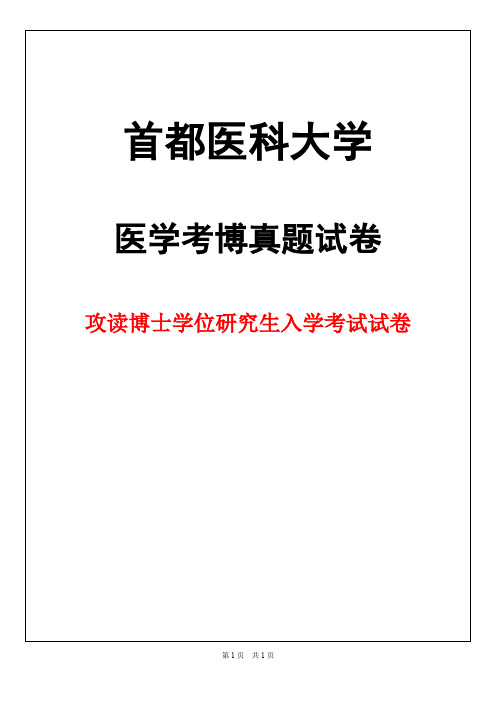
3.自主神经系统是什么?他们都有哪些作用。
首都医科大学
医学考博真题试卷
攻读博士学位研究生入学考试试卷
ቤተ መጻሕፍቲ ባይዱ首都医科大学
2019年攻读博士学位研究生入学考试试题
考试科目:生理学
注意:所有答案一律写在答题纸上,写在试题纸上或其他地方一律不给分。
一、名词解释
1.hemostasis
2.osmotic diuresis
3.cardiac output
4.blood group
5.hypothalamic regulatory peptides
6.阈强度
7.通气血流比值
8.基本电节律
9.基础代谢率
10.回反性抑制
二、简答题
1.临床上促凝血和抗凝血的常用措施
2.心肌和骨骼肌收缩的差异
3.简述动脉血压的影响因素
4.影响氧解离曲线的因素
5.消化道平滑肌的生理特性
三、论述题
1.分析予坐骨神经适当的刺激,相应的骨骼肌收缩的过程
医学博士生考试真题
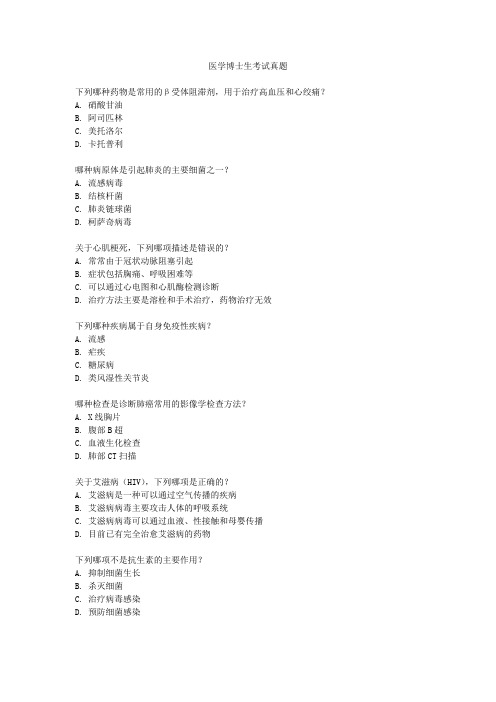
医学博士生考试真题
下列哪种药物是常用的β受体阻滞剂,用于治疗高血压和心绞痛?
A. 硝酸甘油
B. 阿司匹林
C. 美托洛尔
D. 卡托普利
哪种病原体是引起肺炎的主要细菌之一?
A. 流感病毒
B. 结核杆菌
C. 肺炎链球菌
D. 柯萨奇病毒
关于心肌梗死,下列哪项描述是错误的?
A. 常常由于冠状动脉阻塞引起
B. 症状包括胸痛、呼吸困难等
C. 可以通过心电图和心肌酶检测诊断
D. 治疗方法主要是溶栓和手术治疗,药物治疗无效
下列哪种疾病属于自身免疫性疾病?
A. 流感
B. 疟疾
C. 糖尿病
D. 类风湿性关节炎
哪种检查是诊断肺癌常用的影像学检查方法?
A. X线胸片
B. 腹部B超
C. 血液生化检查
D. 肺部CT扫描
关于艾滋病(HIV),下列哪项是正确的?
A. 艾滋病是一种可以通过空气传播的疾病
B. 艾滋病病毒主要攻击人体的呼吸系统
C. 艾滋病病毒可以通过血液、性接触和母婴传播
D. 目前已有完全治愈艾滋病的药物
下列哪项不是抗生素的主要作用?
A. 抑制细菌生长
B. 杀灭细菌
C. 治疗病毒感染
D. 预防细菌感染
哪种药物常用于降低血脂,预防心血管疾病?
A. 利尿剂
B. 胰岛素
C. 他汀类药物
D. 抗生素。
首都医科大学天坛医院 神经病学2019年考博真题试卷
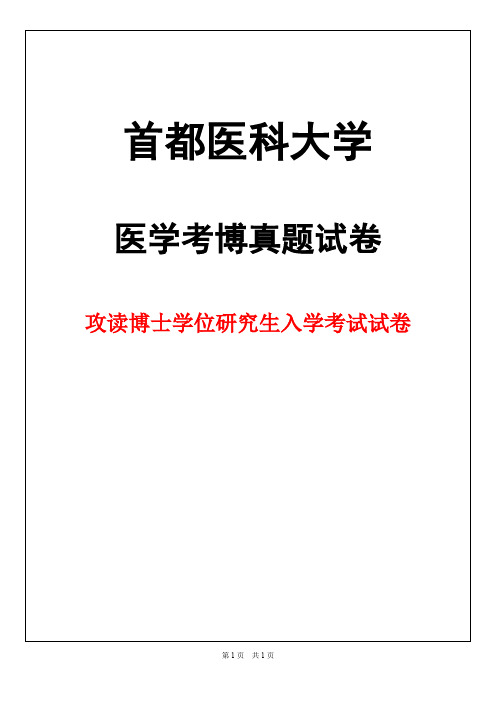
3、阿尔茨海默病的病理及临床表现?
4、DSA技术
5、待补充
四、论述题(45分)
1、脊髓间歇性跛行的特征,与马尾性间歇性跛行及血管性间歇性跛行的区别?(15分)
2、CADASIL与CARASIL的鉴别,把中英文名字全称写出来?(15分)
3、血管性认知障碍的概念、意义、分类及诊断?(15分)
首都医科大学
医学考博真题试卷
攻读博士学位研究生入学考试试卷
首都医科大学(天坛医院)
2019年攻读博士学位研究生入学考试试题
考试科目:神经病学
注意:所有答案一律写在答题纸上,写在试题纸上或其他地方一律不给分。
一、名词解释(2分×5个,10分)
1、Mill Fisher综合征2、 Nhomakorabeadie综合征
3、Beevor征
4、Meige综合征
5、Brun综合征
二、选择题(2分×5个,10分)
1、
2、
3、
4、关于听力检查,说法错误的是A声强就是分贝B正常成年人听力平均分贝是0级C青年人的听力是0级D青年人的听力是0分贝
5、老年性痴呆与血管性痴呆的鉴别金标准是C Hachinski评分
二、简答题(7分×5个,35分)
1、急性炎性脱髓鞘性神经根神经病包括哪些亚型?
XXX2019年考博真题试卷
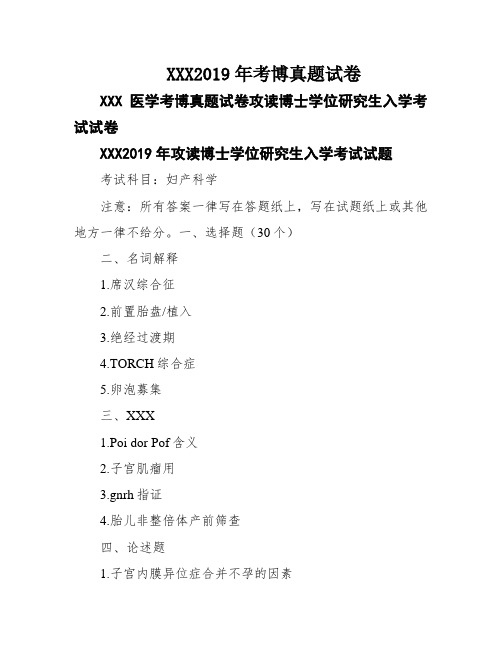
XXX2019年考博真题试卷
XXX医学考博真题试卷攻读博士学位研究生入学考试试卷
XXX2019年攻读博士学位研究生入学考试试题
考试科目:妇产科学
注意:所有答案一律写在答题纸上,写在试题纸上或其他地方一律不给分。
一、选择题(30个)
二、名词解释
1.席汉综合征
2.前置胎盘/植入
3.绝经过渡期
4.TORCH综合症
5.卵泡募集
三、XXX
1.Poi dor Pof含义
2.子宫肌瘤用
3.gnrh指证
4.胎儿非整倍体产前筛查
四、论述题
1.子宫内膜异位症合并不孕的因素
2.葡萄胎后滋养细胞疾病的诊断
3.XXX前期的预测和预防
五、病例分析题
停经51天hcg6000多,b超提醒宫外孕,双侧卵巢囊肿,后手术,术中没瞥见反常,只剥了右边囊肿,术后查hcg ,mtx 保守医治,复查hcg,查b超提醒右边附件宫外孕约7周,胚胎存活,问诊断鉴别诊断,医治方案?。
首都医科大学博士入学考试生理试题(附答案)
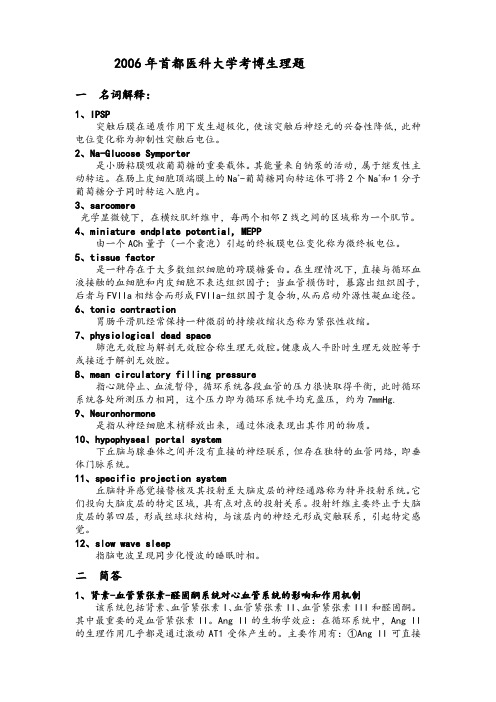
2006年首都医科大学考博生理题一名词解释:1、IPSP突触后膜在递质作用下发生超极化,使该突触后神经元的兴奋性降低,此种电位变化称为抑制性突触后电位。
2、Na-Glucose Symporter是小肠粘膜吸收葡萄糖的重要载体。
其能量来自钠泵的活动,属于继发性主动转运。
在肠上皮细胞顶端膜上的Na+-葡萄糖同向转运体可将2个Na+和1分子葡萄糖分子同时转运入胞内。
3、sarcomere光学显微镜下,在横纹肌纤维中,每两个相邻Z线之间的区域称为一个肌节。
4、miniature endplate potential, MEPP由一个ACh量子(一个囊泡)引起的终板膜电位变化称为微终板电位。
5、tissue factor是一种存在于大多数组织细胞的跨膜糖蛋白。
在生理情况下,直接与循环血液接触的血细胞和内皮细胞不表达组织因子;当血管损伤时,暴露出组织因子,后者与FVIIa相结合而形成FVIIa-组织因子复合物,从而启动外源性凝血途径。
6、tonic contraction胃肠平滑肌经常保持一种微弱的持续收缩状态称为紧张性收缩。
7、physiological dead space肺泡无效腔与解剖无效腔合称生理无效腔。
健康成人平卧时生理无效腔等于或接近于解剖无效腔。
8、mean circulatory filling pressure指心跳停止、血流暂停,循环系统各段血管的压力很快取得平衡,此时循环系统各处所测压力相同,这个压力即为循环系统平均充盈压,约为7mmHg.9、Neuronhormone是指从神经细胞末梢释放出来,通过体液表现出其作用的物质。
10、hypophyseal portal system下丘脑与腺垂体之间并没有直接的神经联系,但存在独特的血管网络,即垂体门脉系统。
11、specific projection system丘脑特异感觉接替核及其投射至大脑皮层的神经通路称为特异投射系统。
它们投向大脑皮层的特定区域,具有点对点的投射关系。
2019年全国医学博士英语统一考试试题
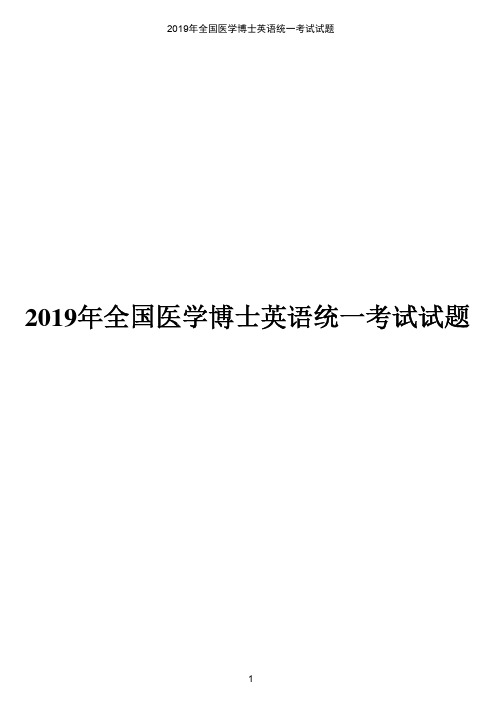
2019年全国医学博士英语统一考试试题2019年全国医学博士英语统一考试试题Part I Listening Comprehension(30%)略Part II Vocabulary(10%)Section ADirections:In this section,all the sentences are incomplete.Four words or phrases marked A,B,C and D are given beneath each of them.You are to choose the word or phrase that best completes the sentence,then mark your answer on the ANSWER SHEET.31.According to the Geneva_____no prisoners of war shall be subject to abuse.A.CustomsB.CongressesC.ConventionsD.Routines32.Environmental officials insist that something be done to___acid rain.A.CurbB.sureC.detoxifyD.condemn33.It is impossible to say how it will take place,because it will happen____,and it will not be along process.A.spontaneouslyB.simultaneouslyC.principallyD.approximately34.Diabetes is one of the most____and potentially dangerous disease in the World.A.CrucialB.virulentC.colossalD.prevalent35.Rheumatologist advises that those with ongoing aches and pains first seek medical help to____the problem.A.AffiliateB.alleviateC.aggravateD.accelerate36.How is it possible that such____deception has come to take place right under our noses?A.obviousB.significantC.necessaryD.widespread37.Now a paper in Science argues that organic chemicals in the rock come mostly from____onearth rather than bacteria on Mars.A.ConfigurationB.constitutionC.condemnationD.contamination38.Chronic high-dose intake of vitamin A has been shown to have____effects on bones.A.adverseB.prevalentC.instantD.purposeful39.Generally,vaccine makers_____the virus in fertilized chicken eggs in a process that can takefour to six months.A.penetrateB.designateC.generateD.exaggerate40.We are much quicker to respond,and we respond far too quickly by giving___to our anger.A.ventB.impulseC.temperD.Offence Section BDirections:Each of the following sentences has a word or phrase underlined.There are four words or phrases beneath each sentence.Choose the word or phrase which can best keep the meaning of the original sentence if it is substituted for the underlined part.Mark your answer on the ANSWERSHEET.41.The patient's condition has worsened since last night.A.improvedB.returnedC.deterioratedD.changed42.Beijing Television-Station Transmitting Tower really looks magnificent at night when it's litup.A.decoratedB.illustratedC.illuminatedD.entertained43.Attempts to restrict parking in the city centre have further aggravated the problem of trafficcongestion.A.amelioratedB.aggregatedC.deterioratedD.duplicated44.The applications of genetic engineering are abundant and choosing one appropriate for thiscase can be rather difficult.A.sufficientB.plentifulC.adequateD.countable45.The defect occurs in the first eight weeks of pregnancy,though no one understands why.A.deficitB.deviationC.draw backD.discrepancy46.He has been on hormone alternate therapy for four years and looks fantastic.A.successorB.replacementC.surrogateD.choice47.It had over2,000apartment complexes,a great market,a large number of industrial workshops,an administrative center,a number of massive religious edifices,and a regular grid pattern of streets and buildings.A.ancientB.carefullyC.very largeD.carefully protected48.When patients spend extended periods in hospital,they tend to become overly dependent andlose interest in taking care of themselves.A.extremelyB.exclusivelyC.exactlyD.explicitly49.The anxious parent was vigilant over the injured child in spite of a full array of emergencyroom of doctors and nurses.A.preoccupiedB.unwaryC.watchfulD.dozing50.The doctor vacillated so frequently on disease-prevention techniques that his colleaguesaccused him of inconsistency.A.waveredB.instigatedC.experimentedD.reliedPartⅢCloze(10%)Directions:In this section there is a passage with ten numbered blanks.For each blank,there are four choices marked A,B,C and D on the right side.Choose the best answer and mark the letter of your choice on the ANSWER SHEET.We spend a lot of time looking at the eyes of others for social51—it helps us understand a person's emotions,and make decisions about how to respond to them.We also know that adultsavoid eye contact when anxious.But researchers have known far52about eye gazing patterns in children.According to new research by Kalina Michalska,assistant professor of psychology at the University of California,Riverside,we now know that anxious children tend to avoid making eye contact,and this has consequences for how they experience fear.The53and less frequently they look at the eyes of others,the more likely they are to be afraid of them,even when there may be no reason to be.Her study,"Anxiety Symptoms and Children's Eye Gaze During Fear Learning",was published in the journal The Journal of Child Psychology and Psychiatry.“Looking at someone's eyes helps us understand whether a person is feeling sad,angry,fearful, or surprised.As adults,we then make decisions about how to respond and what to do next.But,we know much less about eye patterns in children—so,understanding those patterns can help us learn more about the development of social learning,"Michalska said.Michalska and the team of researchers showed82children,9to13years old,images of two women's faces on a computer screen.The computer was equipped with an eye tracking device that allowed them to measure54on the screen children were looking,and for how long.The participants were originally shown each of the two women a total of four times.Next,one of the images was55 with a loud scream and a fearful expression,and the other one was not.At the end,children saw both faces again without any sound or scream.The following three conclusions can be drawn from the study:1.All children spent more time looking at the eyes of a face that was paired with the loud scream than the face that was not paired with the scream,56they pay attention to potential threats even in the absence of outward cues.2.Children who were more anxious avoided eye contact during all three phases of the experiment,for both kinds of faces.This had consequences for how afraid they were of the faces.3.The more children avoided eye contact;the more afraid they were57the faces.The conclusions suggest that children spend more time looking at the eyes of a faces when previously paired with something frightening suggesting they pay more attention to potentially threatening information as a way to learn more about the situation and plan what to do next.However,anxious children tend to avoid making eye contact,which leads to greater58 experience.Even though avoiding eye contact may reduce anxiety59,the study finds that—over time—children may be missing out60important social information.This includes that a person may no longer be threatening or scary,and yet the child continues feeling fearful of that person.51.A.environment B.cues C.relations D.answers52.A.less B.more C.enough D.beyond53.A.longer B.more anxious C.shorter D.more54.A.where B.when C.how D.what55.A.followed B.recorded C.paired D.marked56.A.suggest B.suggesting C.suggests D.being suggested57.A.to B.of C.at D.about58.A.fear B.surprise C.sad D.angry59.A.in the long run B.for a long timeC.in the short timeD.in a long time60.A.with B.without C.of D.onPart IV Reading Comprehension(30%)Directions:In this part,there are six passages,each of which is followed by five questions.For each question,there are four possible answers marked A,B,C,and D.Choose the best answer and mark the letter of your choice on the ANSWER SHEET.Passage OneThe British psychoanalyst John Bowlby maintains that separation from the parents during the Sensitive"attachment"period from birth to three may scar a child's personality and predispose to emotional problems in later life.Some people have drawn the conclusion from Bowlby's work that children should not be subjected to day care before the age of three because of the parental separation it entails,and many people do believe this.It has been argued that an infant under three who is cared for outside the home may suffer because of the separation from his parents.But there are also arguments against such a strong conclusion.But traditional societies are so different from modern societies that comparisons based on just one factor are hard to interpret.Firstly,anthropologists point out that the insulated love affair between children and parents formed in modern societies does not usually exist in traditional societies.For example,in some tribal societies,such as the Ngoni,the father and mother of a child did not rear their infant alone—far from it.Certainty,Bowlby's analysis raises the possibilities that early day care had delayed effects.The possibility that such care might lead to,say,more mental illness or crime15or20years later can only explored by the use of statistics.However,statistical studies of this kind have not yet been carried out,and even if they were,the results would certainly be complicated and controversial. Secondly,common sense tells us that day care would not be so widespread today if parents, care-takers found children had problems with it.Thirdly,in the last decade,there have been a number of careful American studies of children in day care,and they have uniformly reported that care had a neutral or slightly positive effect on children's development.Whatever the long-term effects,parents sometimes find the immediate effects difficult to deal with.Children under three are likely to protest at leaving their parents and show unhappiness.At the age of three or three and a half almost all children find the transition to nursery easy,and this is undoubtedly why more and more parents make use of child care at this time.The matter,then,is far from clear-cut,though experience and available evidence indicate early care is reasonable forinfants.61.According to the passage,the consequence of parental separation______.A.still needs more statistical studiesB.has been found negative is more seriousC.is obviousD.in modern times62.The author thinks that John Bowlby's concern_____.A.is relevant and justifiableB.is too strong to believeC.is utterly groundlessD.has something that deserve our attention63.What's the result of American studies of children in day care in the last decade?A.The children's unhappiness and protest was due to the day care the children received.B.The bad effects of parental separation were hard to deal with.C.The effect of day care was not necessarily negative on children's development.D.Early care was reasonable for babies since it's practiced by so any people nowadays.64.According to the passage,which of the following is probably a reason for parents to send theirchildren under three to day care?A.They don't know about day care's negative effect.B.They are too busy to care for their children.C.They want their children to be independent as early as possible.D.They want to facilitate their children to adapt to nursery at the age of about three.65.What's the author's attitude to people who have drawn the conclusion from Bowl-by's workthat children should not be subjected to day care before the age of three?A.He supports most of their belief because Bowlby's preposition is well-grounded.B.He is sympathetic for them,for he thinks they have been misled by Bowlby.C.He doesn't totally agree with them,since the long-term effect of day care still needs furtherstudy.D.He doesn't quite understand them,as they are contradictory in themselves.Passage TwoBy the end of this century,the average world temperature is expected to increase between one and four degrees,with widespread effects on rainfall,sea levels and animal habitats.But in the Arctic,where the effects of climate change are most intense,the rise in temperature could be twice as much.Understanding how Arctic warming will affect the people,animals,plant and marine life and economic activity in Canada's North are important to the country's future,says Kent Moore,an atmospheric physicist at University of Toronto Mississauga who is participating in a long-term,international study of the marine ecosystem along the Beaufort Sea.from Alaska to the Mackenzie delta.The study will add to our knowledge of everything from the extent of sea ice in the region to how fish stocks will change to which areas could become targets for oil and gas exploration to the impact on the indigenous people who call this part of the country home.Moore,who has worked in the Arctic for more than20years,says his research has already found that thinning sea ice and changes in wind patterns are causing an important change in the marine food chain;phytoplankton(浮游植物)is blooming two to three weeks earlier.Many animals time their annual migration to the Arctic for when food is plentiful,and have not adapted to the earlier bloom."'Animals'behavior can evolve over a long time,but these climate changes are happening in the space of a decade,rather than hundreds of years,"says Moore,"Animals can't change their behavior that quickly."A warmer Arctic is expected to have important effects on human activity in the region,as the Northwest Passage becomes navigable during the summer,and resource extraction becomes more rmation gained from the study will help government,industry and communities make decisions about resource management,economic development and environmental protection.Moore says the study—which involves Canadian,American and European researchers and government agencies will also use a novel technology to gather atmospheric data:remotely piloted drones."The drones have the capability of a large research aircraft,and they're easier to deploy,"he says,showing the researchers to gather information on a more regular basis than they would be able to with piloted aircraft.66.By the end of this century,according to the author,global warming will____.A.start to bring about extreme weather events to humans and animalsB.increase the average world temperature by four degreesC.cause more damages to the whole world than expectedD.affect the Arctic more than any other parts of the earth67.To help understand the destructive mechanism of Arctic warming,as indicated by the passage,the international study______.A.is conducted with every single discipline of University of TorontoB.pioneers in pursuing the widespread effects of climate changeC.involves so many countries for different investigationsD.is intended to deal with various aspects in research68.When he ways,"Animals can't change their behavior that quickly,"what does Moore mean bythat quickly?A.The migration of the animals to the Arctic.B.The widespread effects of global warming.C.The rate of the climate change in the Arctic.D.The phytoplankton within the marine ecosystem.69.According to the author,to carry our proper human activities in the Arctic_____.A.becomes more difficult than ever beforeB.is likely to build a novel Economy in the regionC.will surely lower the average world temperatureD.needs the research-based supporting information70.With the drones deployed,as Moore predicts,the researchers will______.A.involve more collaborating countries than they do nowB.get more data to be required for their researche more novel technologies in researchD.conduct their research at a regular basisPassage ThreeHaving too much caffeine during pregnancy may impair baby'liver development and increase the risk of liver disease in adulthood,according to a study published in the Journal of Endocrinology. Pregnant rats given caffeine had offspring with lower birth weights,altered growth and stress hormone levels and impaired liver development.The study findings indicate that consumption of caffeine equivalent to2-3cups of coffee may alter stress and growth hormone levels in a manner that can impair growth and development,and increase the risk of liver disease in adulthood.Previous studies have indicated that prenatal caffeine intake of300mg/day or more in women, which is approximately2to3cups coffee per day,can result in lower birth weights of their children. Animal studies have further suggested that prenatal caffeine consumption may have more detrimental long-term effects on liver development with an increased susceptibility to non-alcoholic fatty liver disease,a debilitating condition normally associated with obesity and diabetes.However, the underlying link between prenatal caffeine exposure and impaired liver development remains poorly understood.A better understanding of how caffeine mediates these effects could help prevent these health issues in people in the future.In this study,Prof Hui Wang and colleagues at Wuhan University in China,investigated the effects of low(equivalent to2-3cups of coffee)and high doses(equivalent of6-9cups of coffee) caffeine,given to pregnant rats,on liver function and hormone levels of their offspring.Offspring exposed to prenatal caffeine had lower level of the liver hormone,insulin like growth factor(IGF-1), and higher levels of the stress hormone,corticosteroid at birth.However,liver development after birth showed a compensatory'catch up'phase,characterized by increased levels of IGF-1,which is important for growth.Dr.Yinxian Wen,study co-author,says,"Our results indicate that prenatal caffeine causes an excess of stress hormone activity in the mother,which inhibits IGF-1activity for liver development before birth.However,compensatory mechanisms do occur after birth to accelerate growth and restore normal liver function,as IGF-1activity increases and stress hormone signalling decreases.The increased risk of fatty liver disease caused by prenatal caffeine exposure is most likely a consequence of this enhanced,compensatory postnatal IGF-1activity."These findings not only confirm that prenatal caffeine exposure leads to lower birth weight and impaired liver development before birth but also expand our current understanding of the hormonal changes underlying these changes and suggest the potential mechanism for increased risk of liver disease in the future.However,these animal findings need to be confirmed in humans.Dr.Wen comments,"Our work suggests that prenatal caffeine is not good for babies and although these findings still need to be confirmed in people,I would recommend that women avoid caffeine during pregnancy."71.Which of the following is NOT the problem of baby rats of pregnant rats given caffeine?A.Lower birth weight.B.Smaller stress.C.Liver development problem.D.Growth problem.72.If a pregnant woman takes3cups of coffee,what will probably happen?A.Her weight will get lower and lower.B.The weight of her baby will get lower and lower.C.She will suffer from non-alcoholic fatty liver disease in a long run.D.Her baby will be more vulnerable to obesity and diabetes because of liver problem.73.Which of following is not correct according to the passage?A.A better understanding of the relationship between caffeine and effects has been achieved.B.4-5cups of coffee could be categorized as medium-dose intake.C.Liver development problem may be remedied after birth by increased growth factor.D.The study is mainly conducted on the rats instead of human.74.What is the relationship between stress hormone and liver development when taking inprenatal caffeine?A.Lower stress hormone,lower birth weight before birth.B.Higher stress hormone,lower growth hormone before birth.C.Higher stress hormone,more accelerated growth of weight after birth.D.Lower stress hormone,less accelerated growth of liver after birth.75.What can be the best summary of the last paragraph?A.The research hasn’t been done on humans so pregnant women can ignore the results.B.The compensatory mechanism for liver growth makes prenatal caffeine intake safe.C.Experts suggest pregnant women should still avoid caffeine.D.We have known enough about the hormone changes underlying the health problems. Passage FourThe bizarre antics of sleepwalkers have puzzled police,perplexed scientists,and fascinated writers for centuries.There is an endless supply of stories about sleepwalkers.Persons have been said to climb on steep roofs,solve mathematical problems,compose music,walk through plate-glasswindows,and commit murder in their sleep.How many of these stories have a basis in fact,and how many are pure fakery?No one knows, but if some of the most sensational stories should be taken with a barrel of salt,others are a matter of record.In Revere,Massachusetts,a hundred policemen combed a waterfront neighborhood for a lost boy who left his home in his sleep in and woke up five hours later on a strange sofa in a strange living room,with no idea how he had got there.There is an early medical record of a somnambulist who wrote a novel in his sleep.And the great French writer Voltaire knew a sleepwalker who once got out of bed,dressed himself,made a polite bow,danced a minuet,and then undressed and went back to bed.At the University of Iowa,a student was reported to have the habit of getting up in the middle of the night and walking three-quarters of a mile to the Iowa River.He would take a swim and then go back to his room to bed.The world's champion sleepwalker was supposed to have been an Indian,Pandit Ramrakha, who walked sixteen miles along a dangerous road without realizing that he had left his bed.Second in line for the title is probably either a Vienna housewife or a British farmer.The woman did all her shopping on busy streets in her sleep.The farmer,in his sleep,visited a veterinarian miles away.The leading expert on sleep in America claims that he has never seen a sleepwalker.He is Dr. Nathaniel Kleitman,a physiologist at the University of Chicago.He is said to know more about sleep than any other living man,and during the last thirty-five years had lost a lot of sleep watching people sleep.Says he,"Of course,I know that there are sleepwalkers because I have read about them in the newspapers.But none of my sleepers ever walked,and if I were to advertise for sleepwalkers for an experiment,I doubt that I'd get many takers."Sleepwalking,nevertheless,is a scientific reality.Like hypnosis,it is one of those dramatic, eerie,awe-inspiring phenomena that sometimes border on the fantastic.It lends itself to controversy and misconceptions,what is certain about sleepwalking is that it is a symptom of emotional disturbance,and that the only way to cure it is to remove the worries and anxieties that cause it. Doctors say that somnambulism is much more common than is generally supposed.Some have estimated that there are four million somnambulists in the United States.Others set the figure even higher.Many sleepwalkers do not seek help and so are never put on record,which means that an accurate count can never be made.The simplest explanation of sleepwalking is that it is the acting out of a vivid dream.The dream usually comes from guilt,worry,nervousness,or some other emotional conflict.The classic sleepwalker is Shakespeare's Lady Macbeth.Her nightly wanderings were caused by her guilty consience at having committed murder.Shakespeare said of her,"The eyes are open but their sense is shut."The age-old question is:Is the sleepwalker actually awake or asleep?Scientists have decidedthat he is about half-and-half.Like Lady Macbeth,he has weighty problems on his mind,Dr,Zeida Teplitz,who made a ten-year study of the subject,says,"Some people stay awake all night worrying about their problems.The sleepwalker thrashes them out in his sleep.He is awake in the muscular area,partially asleep in the sensory area."In other words,a person can walk in his sleep,move around,and do other things,but he does not think about what he is doing.76.The second sentence in the second paragraph means that_____.A.no one knows,but certainly all the sleep walking stories have something incredibleB.the sleepwalking stories are like salt adding flavor to people's lifeC.sleepwalking stories that are most fantastic should be sorted out from ordinary storiesD.the most fantastic sleepwalking stories may be just fictions,yet there are still truthfullyrecorded stories.77.____was supposed to be the world’s champion sleepwalker.A.The student habitually walked to the Iowa River and swam in his sleepB.The man danced a minuet in his sleepC.The man walker sixteen miles along a dangerous roadD.The boy walked five hours in his sleep78.Sleepwalking is the result of_____according to the passage.A.emotional disorderB.a vivid dreamck of sleep and great anxietyD.insanity79.Dr.Zeida Teplitz seemed to_____.A.agree that sleepwalking sometimes leads to dangerous actsB.conclude that sleepwalkers are awake in their sensory areaC.disagree with the belief that sleep walkers are immune to injuryD.think that sleepwalking can turn into madness80.The writer makes it obvious that_____.A.sleepwalkers are often awakened by dangersB.most sleepwalkers can find ways to avoid self-injuryC.it is important to find out the underlying cause of sleepwalkingD.sleepwalking is actually a kind of hypnosisPassage FiveBeyond the basic animal instincts to seek food and avoid pain,Freud identified two sources of psychic energy,which he called"drives":aggression and libido.The key to his theory is that these were unconscious drives,shaping our behavior without the mediation of our waking minds;they surface,heavily disguised,only in our dreams.The work of the past half-century in psychology and neuroscience has been to downplay the role of unconscious universal drives,focusing instead on rational processes in conscious life.But researchers have found evidence that Freud's drives really do exist,and they have their roots in the limbic system,a primitive part of the brain that operatesmostly below the horizon of consciousness.Now more commonly referred to as emotions,the modern suite of drives comprises five:rage,panic,separation distress,lust and a variation on libido sometimes called seeking.The seeking drive is proving a particularly fruitful subject for researchers.Although like the others it originates in the limbic system,it also involves parts of the forebrain;the seat of higher mental functions.In the1980s,Jaak Panksepp,a neurobiologist at Bowling Green State University in Ohio,became interested in a place near the cortex known as the ventral tegmental area,which in humans lies just above the hairline.When Panksepp stimulated the corresponding region in a mouse, the animal would sniff the air and walk around,as though it were looking for something.Was it hungry?No.The mouse would walk right by a plate of food,or for that matter any other object Paksepp could think of.This brain tissue seemed to cause a general desire for something new."What I was seeing,"he says,"was the urge to do stuff."Panksepp called this seeking.To neuropsychologist Mark Solms of University College in London,that sounds very much like libido."Freud needed some sort of general,appetitive desire to seek pleasure in the world of objects,"says Solms.Panksepp discovered as a neuroscientist what Freud discovered psychologically."Solms studied the same region of the brain for his work on dreams.Since the 1970s,neurologists have known that dreaming takes place during a particular form of sleep known as REM—rapid eye movement—which is associated with a primitive part of the brain known as the pons.Accordingly,they regarded dreaming as a low-level phenomenon of no great psychological interest.When Solms looked into it,though,it turned out that the key structure involved in dreaming was actually the ventral tegmental,the same structure that Panksepp had identified as the seat of the"seeking"emotion.Dreams,it seemed,originate with the libido—which is just what Freud had believed.Freud's psychological map may have been flawed in many ways,but it also happens to be the most coherent and,from the standpoint of individual experience,meaningful theory of the mind. "Freud should be placed in the same category as Darwin,who lived before the discovery of genes," says Panksepp."Freud gave us a vision of a mental apparatus.We need to talk about it,develop it, test it."Perhaps it's not a matter of proving Freud wrong or right,but of finishing the job.81.Freud believed that aggression and libido_____.A.were the only two sources of psychic energyB.could sometimes surface in our conscious lifeC.affected our behavior unconsciouslyD.could appear clearly on our dreams82.Which of the following terms is equivalent to what Freud called libido?A.Emotion.B.Lust.C.Seeking.D.Urge.83.Jaak Panksepp's study on a mouse proves that the seeking drive_____.A.originates in the limbic system。
北京中医药大学病理生理学2019年考博真题试卷

1受体Байду номын сангаас常的类型
2什么是阴离子间隙?临床意义什么?
3DIC出现出血的原因
4肝功能受损时候血糖变化以及机制
5失血性休克时候缺氧的类型及血氧指标的变化
三、问答题(每题10分)
1左心衰时,最早出现的功能变化是什么?其临床表现的程度及机制。
2肺通气血流比例失调时影响因素及机制。
3肾脏“矫枉过正”学说。
北京中医药大学
医学考博真题试卷
攻读博士学位研究生入学考试试卷
北京中医药大学
2019年攻读博士学位研究生入学考试试题
考试科目:病理生理学
注意:所有答案一律写在答题纸上,写在试题纸上或其他地方一律不给分。
1、名词解释
氧自由基
细胞信号转导
病理生理过程
发绀
凋亡蛋白酶
胰岛素抵抗
反常性碱性尿
发热
热休克蛋白
泵--漏机制
4休克时酸中毒类型、机制及影响。
5急性低钾血症时、急性高钾血症时导致无力的原因?
6举例说明因果交替的规律。
20XX首都医科大学博士入学考试生理试题[修改版]
![20XX首都医科大学博士入学考试生理试题[修改版]](https://img.taocdn.com/s3/m/952ad7ce87c24028905fc3a1.png)
第一篇:2014首都医科大学博士入学考试生理试题2014年首都医科大学博士入学考试--- 生理试题一、单项选择题(每题1分,共20分)1、兴奋性周期变化顺序:2、骨骼肌兴奋收缩Ca来源:3、人安静时通气量/血流比值:4、参与尿液稀释浓缩的激素:5、使组织液生成减少的是:6、食物的氧热价:7、8、影响兴奋在心脏传导速度最重要因素:9、心脏的异长调节指:10、肺泡回缩是由于:11、12、快速叩击脚腱,刺激与肌肉相连的什么结构引起肌肉收缩:13、脊髓前角r运动神经元传出冲动增加,会导致:14、消化时胃肠运动属于:15、什么物质可以用于检测肾小球滤过速率:16、什么结构对肾小球滤过的通透性无关:17、骨骼肌放在高渗任氏液中,刺激后会发生现象:18、换气时氧的扩散系数与二氧化碳相比:19、盐酸抑制胃内活动通过什么方式:20、心房容积在什么期最大:二、名词解释(每题3分,共15分)1、Isometric contraction [编者注:等长收缩]2、Hemostasis [编者注:止血]3、房室延搁4、滤过分数5、Postsynaptic facilitation [编者注:突出后易化]三、简答题(每题7分,共35分):1、简述钠钾泵的生理意义;2、与骨骼肌相比,心肌收缩的特点有哪些?3、氧解离曲线的生理意义;4、一次饮1L 清水和饮1L 生理盐水,尿量的变化及其机制分别是什么?5、食物中长期缺碘会造成甲状腺肿大,其生理机制?四、问答题(每题15分,共30分):1、已知细胞的静息电位是K+细胞外扩散造成的,试设计实验证明。
2、如何证明经典的去大脑僵直是r僵直,动物何种情况下会出现α僵直?第二篇:协和医科大学2004年分子生物学(博士入学考试试题回忆版) 协和医科大学2004年分子生物学(博士)1.名解:同工酶染色体染色质核基质转化密码子的偏嗜性基因簇2.简答为什么核酸和蛋白都是有方向的?信号转导的cAMP通路什么是内切酶的星号活性3.判断对错,说明理由关于乳糖操纵子的4.论述给定一个cDNA序列,如何表达,纯化到蛋白质5.填空协和生化的老主任是谁(这道题好变态)谁用什么实验证明了核酸是遗传物质可以磷酸化的氨基酸是哪三个带苯环的氨基酸是哪三个DNA在多少nm有最大的光吸收,为什么?第三篇:复旦大学博士研究生入学考试试题复旦大学——文史哲综合2004年博士研究生入学考试试题04复旦考博入学试题——文史哲综合名词解释(6*5):魔幻现实主义;类书;玄言诗;“形而上”;词汇学;?填空(10*1’):[古今中外都有,难度不大,关键是范围广,不易复习,感觉只能靠平时积累] 选择(15*1’):[感觉与填空差不多,如1969诺贝尔文学奖获得者是哪一位?] 论述(8题选三,3*15’):1、请对儒家的几个代表人物的思想说说你的看法及其现实意义;2、谈谈人文学科对于科技和经济的导向作用;3、试述“垮掉的一代”创作思潮的特点及其对于中国青年文学的影响;4、乾嘉学派在文献整理方面的成就;5、民族和国家的文化交流对古代文学的影响;复旦大学——文史哲专业2003年博士研究生入学考试试题2003复旦博士入学中文系、古籍所各专业文史哲试卷题目该卷适用于古代文学、文艺理论、比较文学、现当代文学、语言学、中国古典文献学等六个方向。
首都医科大学2019年细胞生物学考博士真题
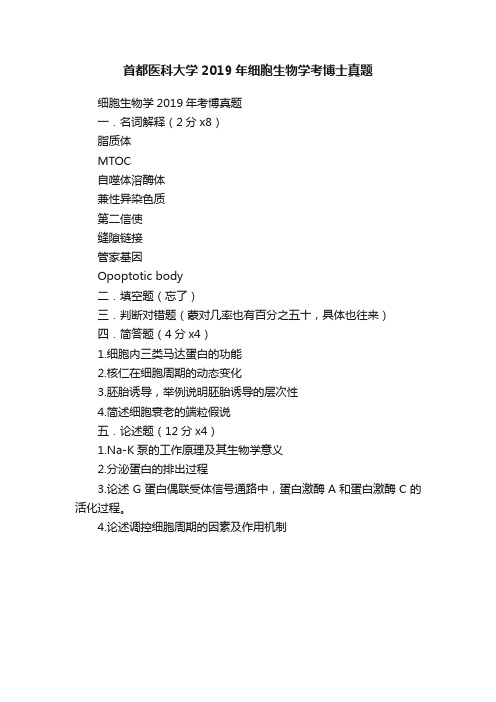
首都医科大学2019年细胞生物学考博士真题
细胞生物学2019年考博真题
一.名词解释(2分x8)
脂质体
MTOC
自噬体溶酶体
兼性异染色质
第二信使
缝隙链接
管家基因
Opoptotic body
二.填空题(忘了)
三.判断对错题(蒙对几率也有百分之五十,具体也往来)
四.简答题(4分x4)
1.细胞内三类马达蛋白的功能
2.核仁在细胞周期的动态变化
3.胚胎诱导,举例说明胚胎诱导的层次性
4.简述细胞衰老的端粒假说
五.论述题(12分x4)
1.Na-K泵的工作原理及其生物学意义
2.分泌蛋白的排出过程
3.论述G蛋白偶联受体信号通路中,蛋白激酶A和蛋白激酶C的活化过程。
4.论述调控细胞周期的因素及作用机制。
完整word版首医考博试题
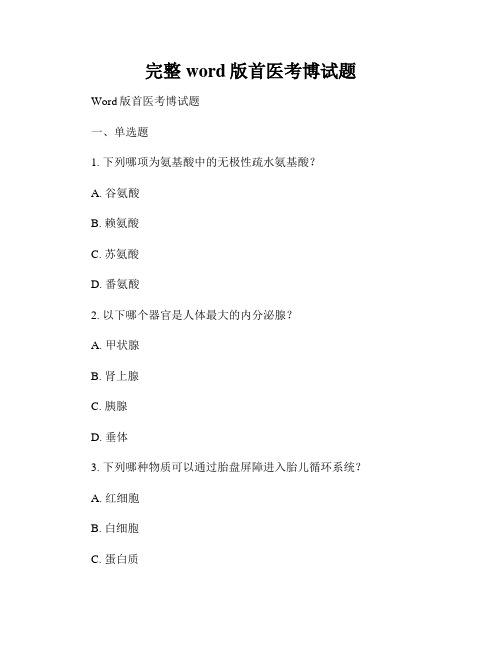
完整word版首医考博试题Word版首医考博试题一、单选题1. 下列哪项为氨基酸中的无极性疏水氨基酸?A. 谷氨酸B. 赖氨酸C. 苏氨酸D. 番氨酸2. 以下哪个器官是人体最大的内分泌腺?A. 甲状腺B. 肾上腺C. 胰腺D. 垂体3. 下列哪种物质可以通过胎盘屏障进入胎儿循环系统?A. 红细胞B. 白细胞C. 蛋白质D. 脂肪酸4. 高浓度的胆汁会导致下列哪种胆结石最易形成?A. 胆盐结石B. 胆固醇结石C. 黑色素结石D. 铁结石5. 下列哪种白细胞在炎症反应中首先出现?A. 嗜好性粒细胞B. 巨噬细胞C. 嗜酸性粒细胞D. 中性粒细胞二、多选题1. 下列哪些物质能穿过血脑屏障?A. 葡萄糖B. 氯化钠C. 氨基酸D. 氯化铵2. 下列哪些形成过程中与凝血无关?A. 纵隔静脉血栓形成B. 动脉粥样硬化斑块形成C. 静脉曲张形成D. 血小板聚集形成血栓3. 以下哪些细胞可以分泌胃酸?A. 表皮细胞B. 刺激细胞C. 壁细胞D. G细胞4. 下列哪些是调节体温的主要因素?A. 室内温度B. 外界温度C. 代谢热D. 神经调节5. 以下哪些物质由肾脏排泄?A. 毒物B. 代谢产物C. 水分D. 药物三、判断题1. 生活垃圾属于医疗废物。
()2. 人体的胆固醇主要通过肝脏代谢清除。
()3. 淋巴系统的主要功能是输送乳汁。
()4. 低钠血症可导致细胞溶解。
()5. 静脉曲张是静脉瓣功能障碍导致的。
()四、简答题1. 请解释生物体的稳态。
生物体的稳态是指在变化的外界条件下,通过内部调节机制使得生物体的内部环境保持相对稳定的状态。
这种稳态使得生物体能够适应外界环境的变化,并保持其正常生理功能的进行。
2. 请解释血液凝固过程中的内外路线。
血液凝固过程中的内外路线是指在不同的刺激下,血液凝结的两条途径。
内路线是由血液内部因子直接参与的凝血过程,外路线是由血管损伤刺激引起的凝血过程。
3. 请解释代谢性酸中毒和呼吸性酸中毒的区别。
医博士考试试题及答案
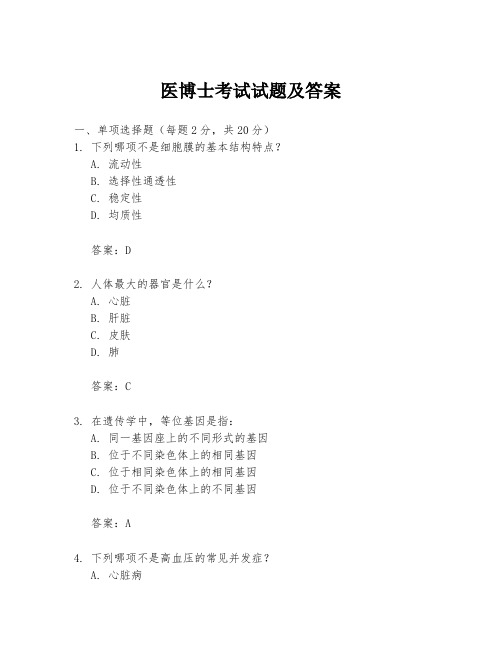
医博士考试试题及答案一、单项选择题(每题2分,共20分)1. 下列哪项不是细胞膜的基本结构特点?A. 流动性B. 选择性通透性C. 稳定性D. 均质性答案:D2. 人体最大的器官是什么?A. 心脏B. 肝脏C. 皮肤D. 肺答案:C3. 在遗传学中,等位基因是指:A. 同一基因座上的不同形式的基因B. 位于不同染色体上的相同基因C. 位于相同染色体上的相同基因D. 位于不同染色体上的不同基因答案:A4. 下列哪项不是高血压的常见并发症?A. 心脏病C. 中风D. 贫血答案:D5. 人体中负责合成血红蛋白的器官是:A. 肝脏B. 骨髓C. 肾脏D. 脾脏答案:B6. 下列哪种维生素是水溶性的?A. 维生素AB. 维生素DC. 维生素ED. 维生素C答案:D7. 哪种类型的细胞死亡是程序化细胞死亡,对生物体有益?A. 坏死B. 凋亡C. 自噬D. 裂解答案:B8. 下列哪项是糖尿病的主要诊断标准?B. 多饮C. 空腹血糖水平D. 随机血糖水平答案:C9. 下列哪种疾病是由人类免疫缺陷病毒(HIV)引起的?A. 乙肝B. 艾滋病C. 麻疹D. 流感答案:B10. 在人体中,哪种类型的细胞负责识别和攻击外来病原体?A. 红细胞B. 白细胞C. 血小板D. 淋巴细胞答案:D二、多项选择题(每题3分,共15分)11. 下列哪些因素可以影响药物的药效?A. 药物剂量B. 给药途径C. 患者的年龄D. 患者的性别答案:A, B, C12. 在医学上,哪些属于一级预防措施?A. 健康教育B. 定期体检C. 疫苗接种D. 高危人群筛查答案:A, B, C13. 下列哪些是心脏骤停的临床表现?A. 意识丧失B. 无自主呼吸C. 脉搏消失D. 血压下降答案:A, B, C14. 下列哪些是糖尿病的常见症状?A. 多尿B. 多饮C. 体重增加D. 多食答案:A, B, D15. 在医学研究中,哪些属于观察性研究方法?A. 队列研究B. 病例对照研究C. 实验研究D. 横断面研究答案:A, B, D三、简答题(每题5分,共20分)16. 简述心脏的四个腔室及其主要功能。
- 1、下载文档前请自行甄别文档内容的完整性,平台不提供额外的编辑、内容补充、找答案等附加服务。
- 2、"仅部分预览"的文档,不可在线预览部分如存在完整性等问题,可反馈申请退款(可完整预览的文档不适用该条件!)。
- 3、如文档侵犯您的权益,请联系客服反馈,我们会尽快为您处理(人工客服工作时间:9:00-18:30)。
第1页 共1页
攻 读 博 士 学 位 研 究 生 入 学 考 试 试 卷
医学考博真题试卷
首都医科大学
第1页 共1页
2019 年攻读博士学位研究生入学考试试题
考试科目:生理学 注意:所有答案一律写在答题纸上,写在试题纸上或其他地方一律不给分。 一、名词解释 1. hemostasis 2. osmotic diuresis 3. cardiac output 4. blood group 5. hypothalamic regulatory peptides 6. 阈强度 7. 通气血流比值 8. 基本电节律 9. 基础代谢率 10. 回反性抑制 二、简答题 1. 临床上促凝血和抗凝血的常用措施 2. 心肌和骨骼肌收缩的差异 3. 简述动脉血压的影响因素 4. 影响氧解离曲线的因素 5. 消化道平滑肌的生理特性 三、论述题 1. 分析予坐骨神经适当的刺激,相应的骨骼肌收缩的过程
